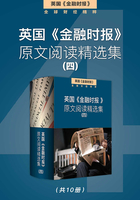
Scientists create life without fertilising an egg (575words)
By Clive Cookson,Science Editor
Scientists have produced healthy offspring without fertilising an egg in a breakthrough that overturns the fundamental principles of embryology.
Bath University biologists bred baby mice by injecting sperm into a non-viable type of embryo called a parthenogenote. This has dividing cells that are fundamentally different from eggs and more like cells elsewhere in the body.
Tony Perry, senior author of the study, said the research could in principle open the way to a “speculative and fanciful” scenario in which sperm are made to fertilise adult cells derived from skin or other tissue. It could even allow two men to become the biological parents of a baby, without female involvement.
“Our work challenges the dogma, held since early embryologists first observed mammalian eggs and fertilisation [in the 19th century], that only an egg cell fertilised with a sperm cell can result in a live mammalian birth,” said Dr Perry, senior author of the study.
“This is an exciting piece of research which may help us to understand more about how human life begins and what controls the viability of embryos — mechanisms which may be important in fertility,” said Paul Colville-Nash, programme manager for developmental biology at the Medical Research Council, which funded the work. “It may one day even have implications for how we treat infertility, though that's probably still a long way off.”
The study, which is published in Nature Communications, began with the chemical stimulation of an unfertilised mouse egg to develop into a parthenogenote. Normally this dies within a few days because it lacks the genetic input from sperm that enables a normal embryo to grow.
The Bath team, which included two Japanese embryologists, Toru Suzuki and Maki Asami, then injected sperm into the parthenogenote. They adapted a technique called Icsi that is frequently used in human IVF fertility treatment to inject sperm into eggs.
Their version, called Phicsi (for parthenogenetic haploid Icsi), triggered the parthenogenote to develop into a normal embryo with genes from both parents: the sperm donor and the original embryo donor. The first pair of mice produced in this way, named Phicsim and Phicsia, grew into healthy adults that then had offspring of their own.
Although the animals seem normal, they are distinctly different from other mice in their “epigenetics” — biochemical markers on their DNA that indicate gene activity. This shows that a fundamentally different form of genetic reprogramming takes place during the Phicsi procedure.
During a press briefing in London, Dr Perry was happy to speculate about the implications. Unlike sperm and eggs, parthenogenotes are “mitotic cells” that divide like the body's other non-reproductive cells. His group is going on to investigate the possibility of adapting mitotic cells like those in skin to undergo a fertilisation procedure like Phicsi.
“Can embryos reprogramme other mitotic cells? Can other mitotic cells reprogramme sperm? Can other mitotic cells reprogramme other mitotic cells?” Dr Perry asked. If so, it may be eventually be possible to “mate” cells of two individuals in the lab without involving sperm or eggs.
“Will we be able to do that? I don't know,” he said. “But I think if it is ever possible one day in the distant future, people will look back and say this is where it started.”
Robin Lovell-Badge, an embryologist Crick Institute in London, said: “I'm not surprised that the authors are excited about this. I think it is a very interesting paper, and a technical tour de force.”
请根据你所读到的文章内容,完成以下自测题目:
1.Which university's biologists have produced healthy offspring without fertilising an egg?
A.Harvard University
B.University of Oxford
C.Tsinghua University
D.Bath University
答案
2.Which one of following is the experimental subject in the study?
A.rabbit
B.mouse
C.human
D.frog
答案
3.Which of the following is not right for the study?
A.It may help us to understand more about how human life begins.
B.It may help us to understand what controls the viability of embryos.
C.The Bath University funded this work.
D.It challenges the dogma as we know.
答案
4.What's the difference between experimental mice and the others?
A.epigenetics
B.appearance
C.propagation
D.nothing
答案